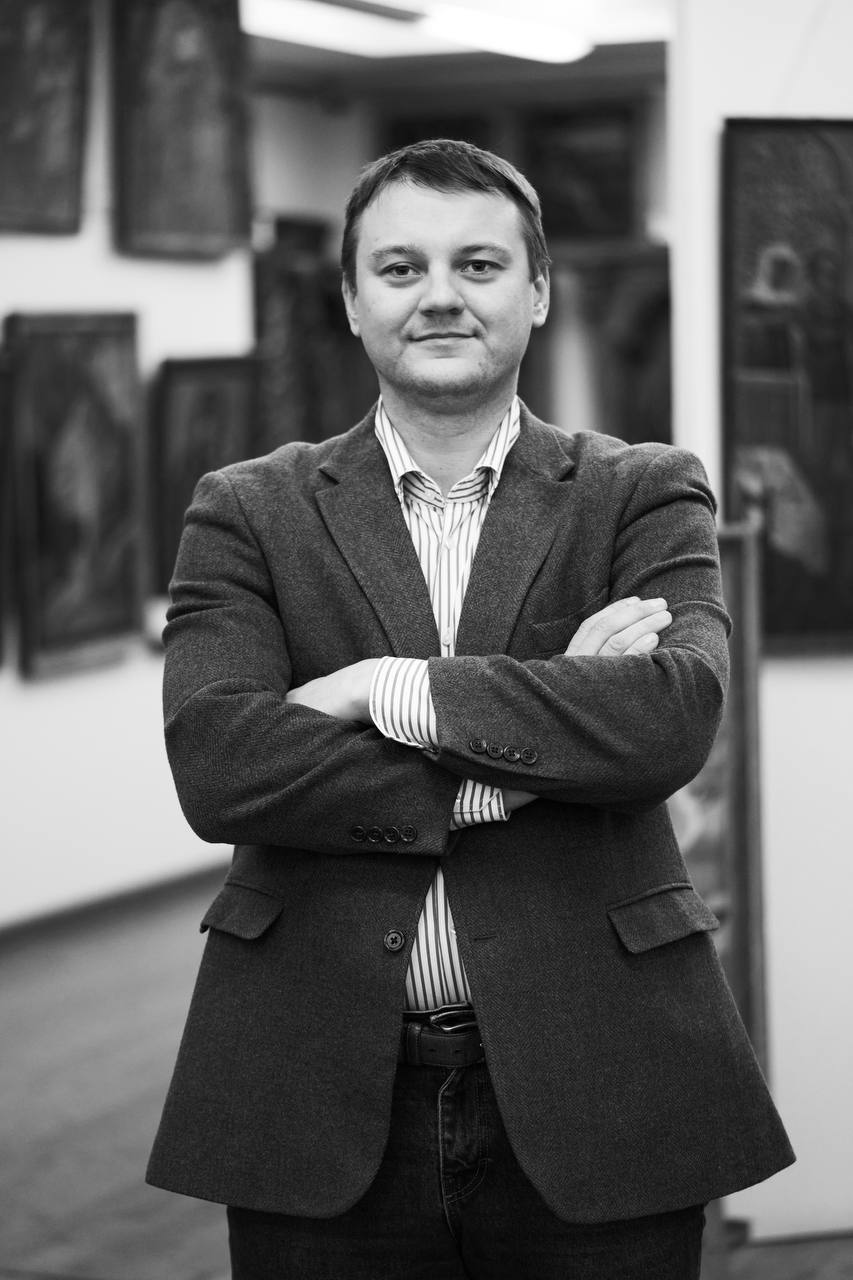
On 8 March 2021, the World Economic Forum in Davos published an article in which Grand Duchess Olha of Kyiv was included among six other women, who had a significant influence on the course of world history. The article provoked the almost instant reaction of former President of Ukraine Petro Poroshenko, who already on 11 March appealed to those at Davos with a request to correct non-historical information about Olha as «a russian ruler and the founder of modern russia». In addition, he noted that the kingdom of Moscow appeared 300 years after the rule of Olha herself and that the capital of Rus, which included modern Ukraine, Belarus, and russia, was Kyiv. Then on 12 March, the Davos group removed St. Olha from the list, basing this on the inconsistency of historical data. This news was received with much criticism in russia, which does not tolerate versions alternative to that of the government.
Why is the figure of St. Olha, who lived more than 1,000 years ago, so controversial, and what is her role in society’s discourse about today’s russian-Ukrainian War? We will try to understand it.

But first, a short excursus about our heroine’s history. We do not have precise data about her birth, approximately at the end of the 9th and beginning of the 10th centuries. Olha was the wife of Grand Duke Ihor of Kyiv (911/922 – 945), who is distinguished in history for his campaigns against Constantinople (941 and 944) and for signing the Byzantium-Rus agreement of 944, advantageous for Rus. However, only a year later, one of the tribes under Kyiv’s control, the Drevlians, dispatched Ihor from this world for, ostensibly, excessive collection of taxes. According to the text of the chronicles, after the murder of Ihor, the Drevlians sent their messengers to Kyiv, with the proposal that Olha marry their duke, Malo. But she refused and began a large number of terrible reprisals, first against the messengers and eventually against the Drevlians.
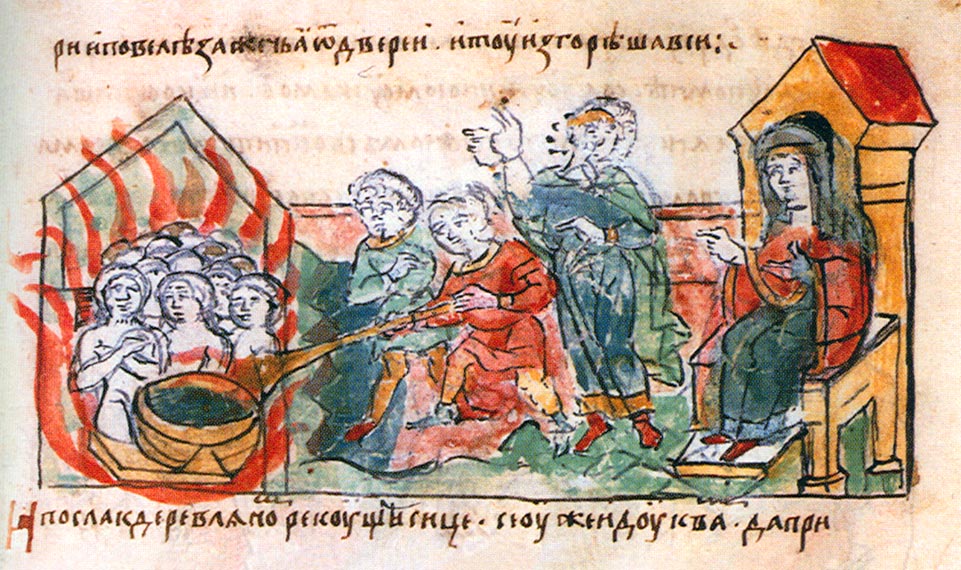
According to the chronicler of Rus, the most dramatic episode in which Olha was involved, in a rather unusual role for a woman in medieval Eastern Europe, a smart military leader, was the siege of the Drevlian city of Iskorosten (today the Ukrainian city of Korosten) in 946, the residents of which were involved with the murder of her husband. In exchange for stopping the siege of the city, Olha asked each nobleman for a dove as a “tax payment.” After she received the doves, tinder was tied to them and they were set on fire. The doves, returning to their buildings, set them on fire.
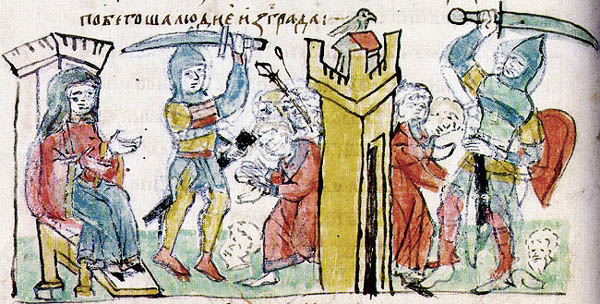
After this, Olha served for almost 20 years as regent for her young son Svyatoslav; she led the enormous state of Rus, the borders of which reached from the shores of the Black Sea to Lake Ladoga and conducted an active internal and external policy. Even before the officially accepted Baptism of Rus in 988, she accepted baptism in Constantinople in 957, thanks to which she has the title of “equal to the apostles,” harbinger of faith in Christ in Rus. She passed into eternity in 969.
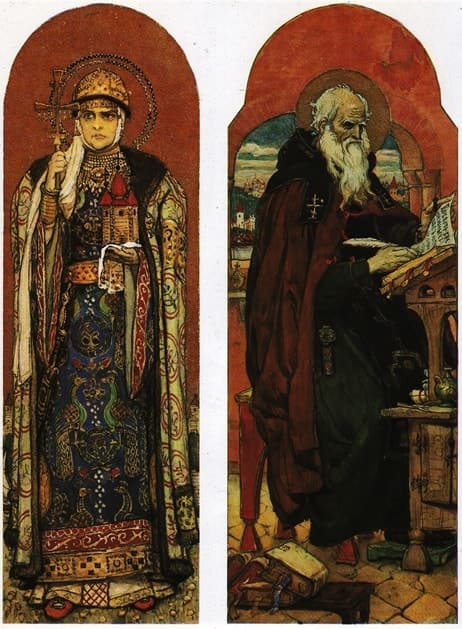
The ”nationality” of Grand Duchess Olha: russian or Ukrainian?
St. Olha is revered by the Orthodox both in Ukraine and in russia, but in ecclesiastical discourse, her «national» origin differs, leading to open or concealed tension. She is unambiguously a Russian saint and grand duchess for the russian Orthodox Church. Patriarch of Moscow Kirill (Gundyayev) emphasizes this, affirming that, thanks to Olha’s personal baptism, the Orthodox faith entered into the consciousness of «many russian people». We recall that, according to the thesis of the official doctrine of the russian Orthodox Church, called the «russian world» [Russkyi mir], Belarusians, Ukrainians, russians and others belong to the “russian people.” This idea is not new; we find such a treatment in pre-revolutionary works (before 1917) of russian scholars and clergy. Accordingly, for the secular authorities of russia, Olha is an exclusively russian grand duchess. In particular, in May 2019 Russian President V. Putin signed an order to re-name dozens of airports with names “of persons who have special merits to the fatherland.” Not considering the controversy over Grand Duchess Olha’s place of birth, an airport in the city of Pskov, where, supposedly, the saint “was born,” was named in her honor, in this way identifying modern russia with medieval Rus. He repeated this assessment at the end of September 2022 in Veliky Novgorod at the celebration of the 1160th anniversary of Russian statehood (!), listing the «pantheon of russian statehood», persons of special merit to the fatherland, from Grand Duke Rurik (9th century) to Gagarin, among whom was recalled Grand Duchess Olha. It is telling that among the 31 named figures, except for Olha, there was only one other woman, Empress Catherine II (1762-1796), who was known for her brutal internal and external policies, which clearly impressed the «heir of the 1000-year-old state.»
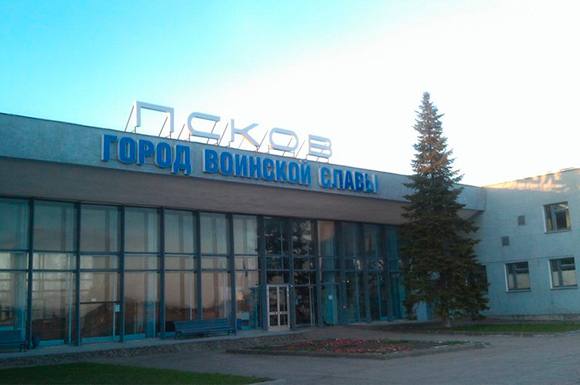
On the other hand, representatives of Ukrainian Orthodoxy (the autocephalous and the Orthodox Church of Ukraine) and Ukrainian Greek-Catholics, reacting since the first half of the 20th century to the russian version, call St. Olha a Ukrainian saint, considering her the harbinger of Christianity in Rus-Ukraine, thus drawing a line of limitation for the right of heirs outside the borders of the modern nation-state. Icons and images of St. Olha in Ukrainian churches manifest this, calling her a “Ukrainian” or “Kyivan” grand duchess. Such an approach, predictably, can call forth the criticism of some researchers of nation-creating processes in Eastern Europe, who consider modern nations the product of the modern era (end of the 18th to middle of the 19th centuries), and in no way rooted in the Middle Ages. But it’s worth mentioning one detail that is difficult to disprove: the Ukrainian version does not go beyond the limits of the borders of the state, and so does not violate norms of international law, as in the russian case (ecclesiastical and secular) with pretensions to the inheritance of former Rus, including the territory of Ukraine. Ukrainians have no desire to “defend” or “inherit” any inheritance in russian Pskov, Novgorod, or Belarusian Polotsk, though they also were under the authority of Olha, who lived and ruled the state from Kyiv.
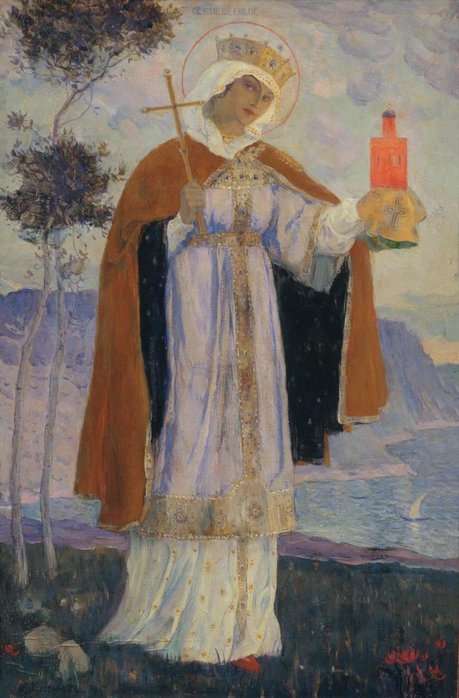
New accents: The Grand Duchess of Kyiv and the russian-Ukrainian War
The feminine dimension of the russian-Ukrainian War is striking. In Ukraine and abroad, hundreds of thousands of Ukrainian women help the Ukrainian army and suffering civilians in various ways. In these difficult realities, women’s social activity and leadership have become even more relevant. The main models for imitation are, of course, contemporaries – from the first lady, who in various areas is defending the interests of Ukrainians, to thousands of famous and not famous women, who serve in the army, rescue, heal, prepare, and some who simply cleverly attack enemy drones, with jars from their homes. They all motivate and inspire with their actions.


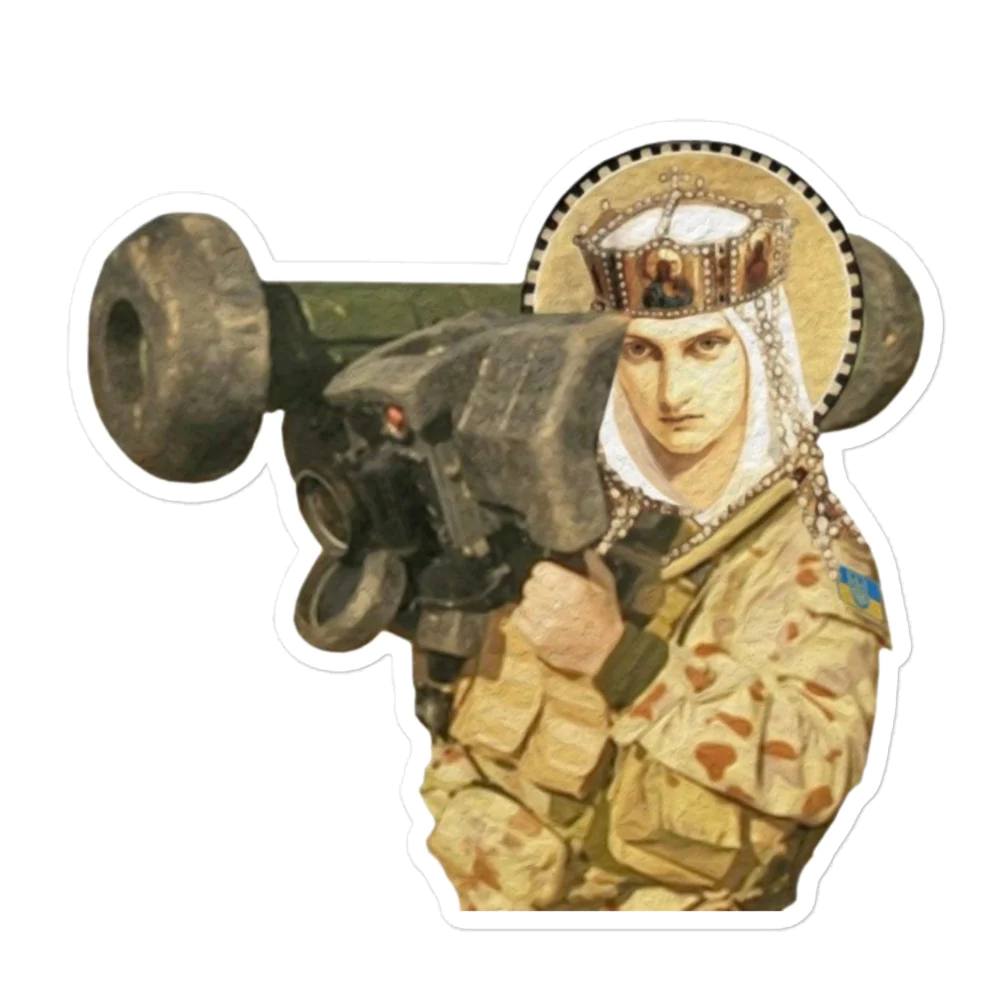
Together with them, historical personalities inspire; the heroic pages of biographies acquire relevance. Defending the historical significance of Ukrainian women in the army, some even refer to Amazons and warring Sarmatian women, calling them “ancient Ukrainians.” Among modern and popular examples, it is possible to recall one of the world’s first women officers of the Ukrainian national army, historian Olena Stepaniv (1892-1963), who successfully fought during the First World War against the russians, was commander of a women’s platoon, and was in russian captivity for two years. And after the conclusion of the First World War, she was involved in the Ukrainian-Polish War of 1918-1919. From 1949 to 1956, she was punished in Soviet camps for pro-Ukrainian activities. In this way, the national pantheon of military heroines is being built, which legitimates an active behavioral model for Ukrainian women in today’s realities, demonstrating to all skeptics that, regarding women in the military, women already did this before and are also doing it now. Such a situation is radically different from the russian situation, where the army remains very patriarchal, and so it does not activate a cult of strong women, compared to men.
And so, in such difficult conditions, the figure of Grand Duchess Olha has become relevant, and not as the grandmother of Grand Duke Volodymyr, or a wise ruler who supported a moderate policy in the south and west, but as a woman who was able effectively to revenge herself against her enemy. In this way, she is presented as one of the old Ukrainian symbols of women’s resistance and defenders in the war of the Ukrainian people. In particular, on the pages of the Ukrainian-language version of the women’s magazine “ELLE,” Grand Duchess Olha, according to the demands of the times, becomes an «iron lady», reminding modern Ukrainian women that their «great-grandmother» «destroyed enemies cruelly and mercilessly». A large image of her (based on an example chosen from a painting of russian artist N. Bruni from 1901) has been popularized by the clothing line «Saint Javelin», which uses conceptual memes – «saints» named in honor of anti-tank and other weapons used on the battlefield and was launched to collect humanitarian aid for Ukrainians. Thus, in this line, St. Olha, together with «saints» «Carl Gustaf» and panzerfaust, armed with a hand-held anti-tank weapon, inspires Ukrainians and allies to victory over the opponent. The profile of Grand Duchess Olha of ancient Rus called to emphasize the resolution and bravery of the modern Ukrainian woman, has begun to beautify the bodies of Ukrainian women already in the form of a tattoo. One Ukrainian woman who during the war wore on her body a portrait image of Grand Duchess Olha in the form of a tattoo explained her decision in a short interview:
«Olha personifies that rage which each of us now feels, which is also a powerful resource for fighting, living, and renewing historical justice. This righteous rage gives us the strength for victory».

In place of the birds and flaming tinders that the grand duchess sent to Iskorosten to burn it, some have even managed to emphasize the «proto-drones».
In addition to this, there is yet another area of making the grand duchess relevant, when the physical beauty of the women of ancient Rus is emphasized, in particular that of the grand duchess. Thus, on the day of her memory, 24 July 2022, at St. Nicholas Parish in Kyiv where it is considered, St. Olha was buried, the photo exhibit «Ukraine-Rus» was presented, with portraits of famous women of Ukraine in images of Grand Duchess Olha and other famous women of ancient Rus.
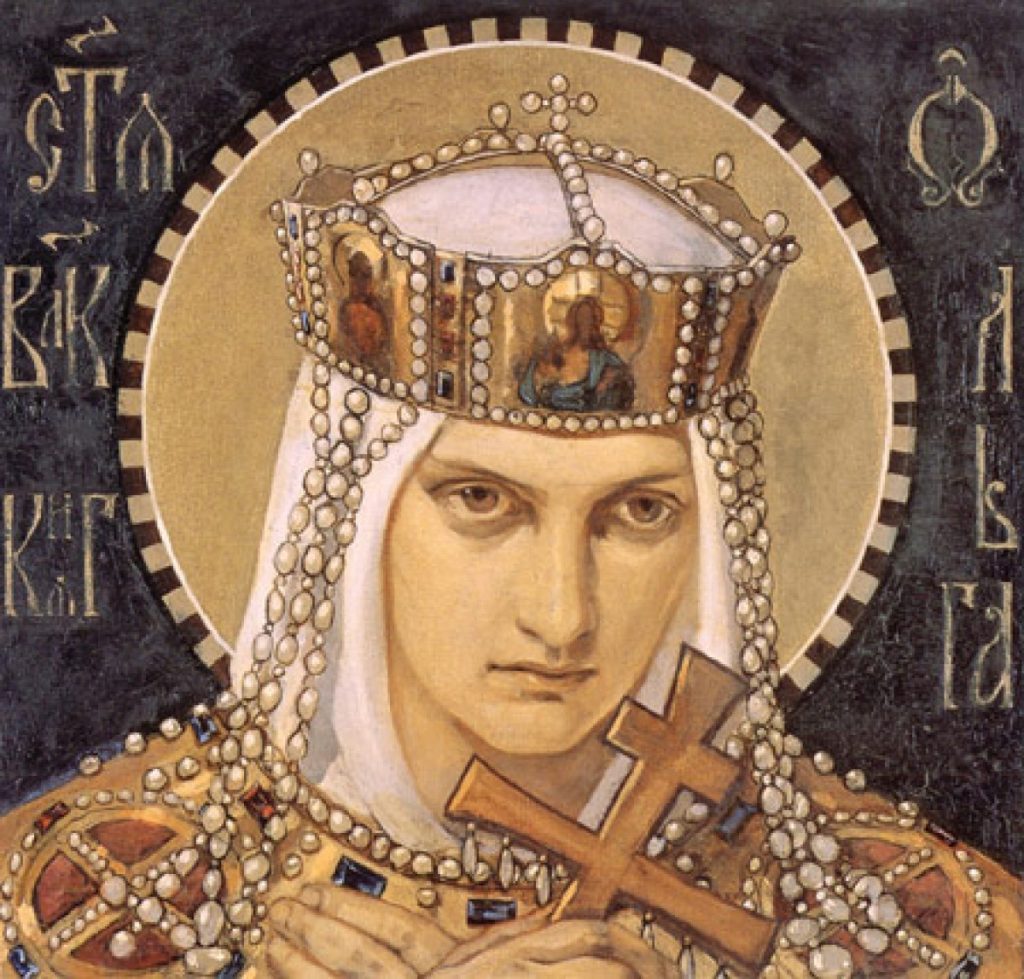
Such attention to Grand Duchess Olha started with the Ukrainian women’s movement, which developed in the first half of the 20th century in the Ukrainian diaspora in the West and chose Olha as its patron. She was for them «the most distinguished woman in Ukrainian history», who demonstrated the “historical” possibility of a woman taking part in state politics. Olha is also an example of the activity of women in the Church, thanks to which she was considered the “patron of Ukraine.” In independent Ukraine Grand Duchess Olha has been confirmed on the government level as an example of womanhood. Since 1997, the highest state award for women for various services has been the Order of Grand Duchess Olha. In May 2022, during her visit to Kyiv, the speaker of the House of Representatives of the US Congress, Nancy Pelosi, received an order from the hands of Ukraine’s president.
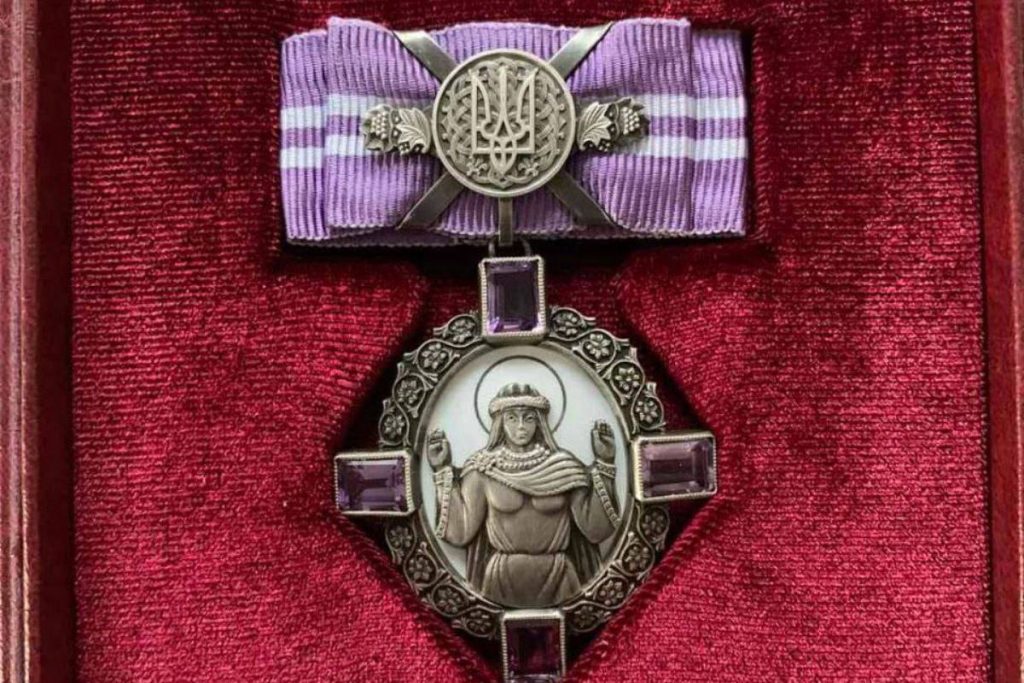
But the special accent on the saint’s successful revenge against the Drevlians, her militarization, appeared during today’s war. Reaction to a brutal and unjust attack is the search for a model protector who was not at a loss but revenged a wrong. There was a similar situation with American feminists who during and after the First World War called for inspiration from the bravery and courage of Joan of Arc.
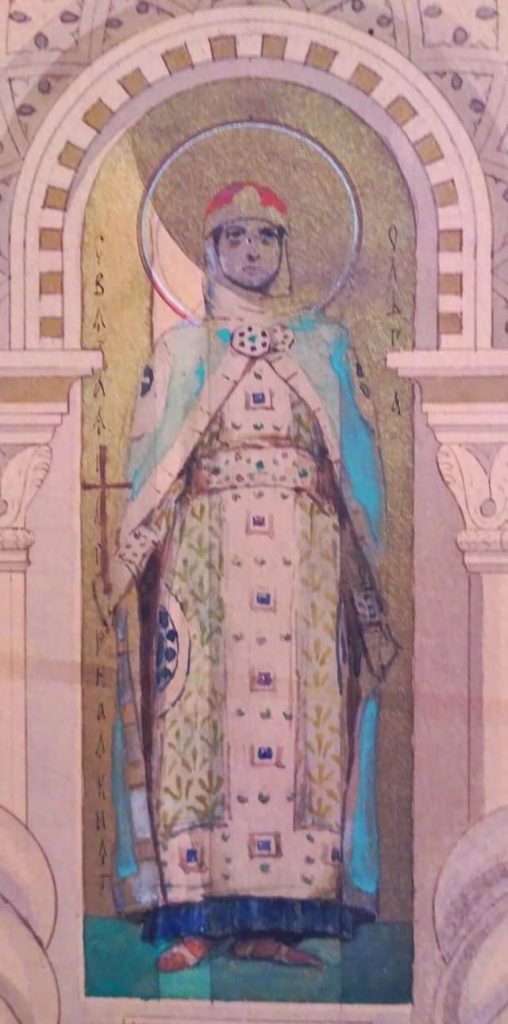
The militarization of St. Olha was already noted during the Second World War. In particular, in the pro-German Ukrainian newspaper «Ukrainian Voice» (22 March 1942) an article appeared, «The tasks of a Ukrainian woman» (the author was hidden under the pseudonym «Yarema»), in which Grand Duchess Olha is at the same time given characteristics of a soldier-knight and of a mother. The author gives the example of Olha’s bloody revenge on the Drevlians for the murder of her husband, defending her homeland. Together with this, she is praised for raising the son of Kyivan Grand Duke Svyatoslav, a true «knight and commander», which should inspire other women whose sons were lost in the darkness of war.

But on the other side of the barricade, the figure of St. Olha is placed in a diametrically opposite discourse. In particular, in March 2022, russian Patriarch Kirill (Gundayev) blessed the war and at the same time read the text of a prayer «To restore peace», in which, together with other saints, the name of Grand Duchess of Kyiv Olha is recalled. But in the summer of 2022, Moscow’s Museum of Victory(!) displayed for public viewing a large cloth (4х6 m) by artist Hryhoriy Hukasov, which was dedicated to St. Olha’s revenge on the Drevlians. It was possible to observe the painting in the realities of the time. The artist himself refused to comment on the contents of the painting, leaving that to the judgment of viewers, though the place of the exhibition of the unfinished work leaves little room for a wide spectrum of versions of its interpretation.
We hope that this cruel page in the narrative of St. Olha will quickly become irrelevant and that the praiseworthy acts of women in this war will, in an appropriate way, be evaluated and recorded (which is already being done actively), and that women will be able to be inspired more by the peaceful state policy of St. Olha.
- Women of history who shaped the world, from a Hawaiian queen to a Chinese empress // World Economic Forum https://www.weforum.org/agenda/2021/03/6-women-of-history-the-world-should-know-better/
- https://regnum.ru/news/polit/3213904.html
- Patriarch Kirill's sermon on the day of remembrance of St. Olga; The russian Orthodox Church celebrated the 1050th anniversary of the repose of the Saint Olga
- Favorov N. Word on the day of St. Blessed and Equal-to-the-Apostles Grand Duchess Olga of russia (at the beginning of the celebration of the 900th anniversary of the Baptism of Rus', July 11, 1888), Proceedings of the Kyiv Theological Academy. No. 9-10. 1888, p. 65; Parkhomenko V. The Ancient russian Princess Saint Equal-to-the-Apostles Olga (the question of her baptism). Kyiv, 1911. S. 21
- Putin called the Novgorod land the cradle of Rus', the source of its civilization and state // TASS russian news agency
- Millennium of Ukrainian Christianity: radio sermon from the Vatican. Rome, 1990. P. 65;
- Vepruk V. Sermon on the Day of Remembrance of the Saint Grand Duchess Olga
- The story about a mallet that knocked down a drone with a can of canning is true. But these were not cucumbers // MC Today
- «Olena Stepaniv. A female soldier» — a documentary film about a Ukrainian defender was released // Army Inform
- St. Olga of Kyiv is Ukraine's patron saint of both defiance and vengeance // The Conversation
- PRINCESS OLGA: THE STORY OF THE GREATEST RULER OF KYIV RUSSIA — THE PROTOTYPE OF THE MODERN INVINCIBLE WOMAN // ELLE UA
- SAINT OLHA - WARRIOR QUEEN ADULT TSHIRT // SAINT JAVELIN
- Princess Olga and «Bayraktary». Women about their new tattoos // DIVOCHE MEDIA
- Drone war: Ukrainian drones helped destroy «Moscow», attacked Sevastopol and winged «strategists», but the main victories are at the front // DUMSKAYA.NET
- https://vechirniy.kyiv.ua/news/69360/
- Saint Princess Olga of Kyiv (From the article of Dr. Anna Harysymovych), Tabarovi visti. Castel, August 25, 1947. Ed. 1. Part 1. P.8; Polonska-Vasylenko N. Prominent women of Ukraine. Winnipeg-Munich, 1969. P. 18.
- Nagaevskii I. Saint Olga-Helena of Rivno-apostles, princess and ruler of russia-Ukraine. Historical essay on the 1000th anniversary of her baptism. Philadelphia, 1955. P. 6.
- President of Ukraine Volodymyr Zelenskyy awarded the speaker of the House of Representatives of the United States of America Nancy Pelosi with the Order of Princess Olga III degree. /// UKRINFORM
- Joan of Arc, for Fascists and Feminists // JSTOR Daily
- Yarema. Tasks of the Ukrainian woman, Ukrainian voice. Proskuriv March 22, 1942. Part 24 (50). P. 3.
